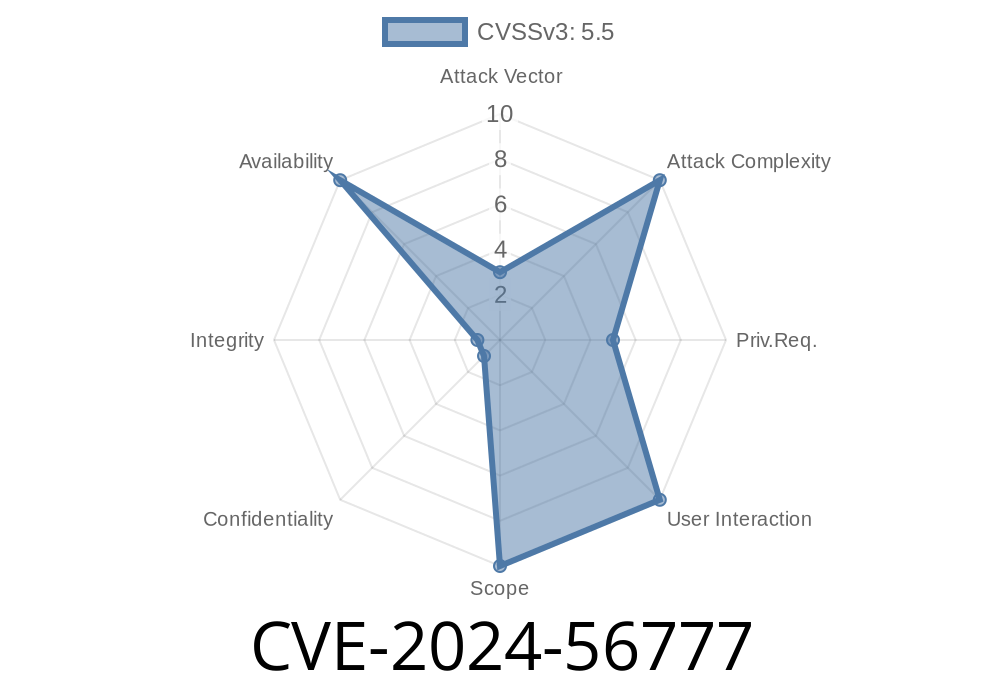CVE-2024-56777 is a recent vulnerability found and patched in the Linux kernel's DRM (Direct Rendering Manager) subsystem, specifically in the driver for STMicroelectronics' graphics hardware, drm/sti. This bug can cause the system to use a pointer that doesn't actually point to valid data – which can lead to a kernel crash or potentially worse security risks.
This issue was fixed by ensuring the kernel checks if a return value signals an error before trying to use it. This article explains the vulnerability, shows you the original buggy code and patch, points to official references, and discusses possible exploit scenarios.
The Bug: Dereferencing Error Pointers
The problem existed in this function: sti_gdp_atomic_check. In recent versions, the code would call:
crtc_state = drm_atomic_get_crtc_state(state, crtc);
// ... and then immediately use crtc_state
But if drm_atomic_get_crtc_state() fails, it returns an error pointer – not a valid crtc_state. Using this error pointer ("dereferencing") crashes the kernel or, if an attacker can control what happens next, opens up the possibility for exploitation.
Here's the Vulnerable Code (Simplified)
struct drm_crtc_state *crtc_state;
crtc_state = drm_atomic_get_crtc_state(state, crtc);
// No check for error!
// Imagine next line tries to access fields in crtc_state
if (!crtc_state->some_flag) {
// ...
}
If drm_atomic_get_crtc_state() failed, crtc_state is not actually a pointer to a real struct drm_crtc_state. Accessing it is super dangerous.
The Fix
The fix is straightforward: check if drm_atomic_get_crtc_state returned an error, using the standard Linux macro IS_ERR():
crtc_state = drm_atomic_get_crtc_state(state, crtc);
if (IS_ERR(crtc_state))
return PTR_ERR(crtc_state);
Patched Code Example
crtc_state = drm_atomic_get_crtc_state(state, crtc);
if (IS_ERR(crtc_state)) {
dev_err(dev->dev, "Failed to get CRTC state!\n");
return PTR_ERR(crtc_state);
}
if (!crtc_state->some_flag) {
// safe: crtc_state really is valid
}
Reference Links
- Linux Kernel Patch Commit
- CVE Record on NVD
- LKML Discussion
Who is affected?
- Linux systems that build kernels with the STMicroelectronics DRM driver (drm/sti).
Attack Scenario
This is a "local" kernel bug — an attacker would need to run code on the target machine. If the sti driver is present and enabled, a low-privileged user could:
1. Craft custom DRM/atomic state objects or operations (often possible via /dev/dri/card* nodes).
Denial-of-Service: System crash, kernel panic.
- Possible Privilege Escalation: If other conditions are met, classic kernel exploitation can turn these bugs into root access. However, kernel security mitigations and the specifics of the error pointer value may limit exploitation.
The outline below shows what an attacker might try, in C using libdrm
#include <fcntl.h>
#include <stdio.h>
#include <stdlib.h>
#include <drm/drm.h>
int main() {
int fd = open("/dev/dri/card", O_RDWR);
if (fd < ) { perror("open"); exit(1); }
// The exploit is highly hardware/driver-specific. In theory:
// - Build a crafted atomic state to trigger error from drm_atomic_get_crtc_state().
// This usually requires deep knowledge of internal hardware state.
// For demonstration, a dumb ioctl poke:
struct drm_mode_crtc crtc = {};
crtc.crtc_id = 9999; // Nonexistent ID, may trigger error path
if (ioctl(fd, DRM_IOCTL_MODE_GETCRTC, &crtc) < ) {
perror("DRM_IOCTL_MODE_GETCRTC");
// If the STI driver is active, driver error handling flaw can crash kernel somewhere after
}
close(fd);
return ;
}
Note: Actual exploitation may be more complex, requiring reverse engineering of hardware setup.
Conclusion
CVE-2024-56777 is a classic case of missing error checks in low-level system code, in this case in the Linux kernel's DRM/sti driver. While its impact is likely limited to special hardware, it underscores the importance of careful pointer management in kernel code. If you’re running a vulnerable kernel with drm/sti enabled, update to a fixed release as soon as possible.
> Software security often comes down to a single line: always check your pointers!
Further Reading
- Kernel Newbies – How To Read A Kernel Patch
- Embedded Graphics (Linux DRM subsystem)
Timeline
Published on: 01/08/2025 18:15:18 UTC
Last modified on: 01/09/2025 21:43:37 UTC
